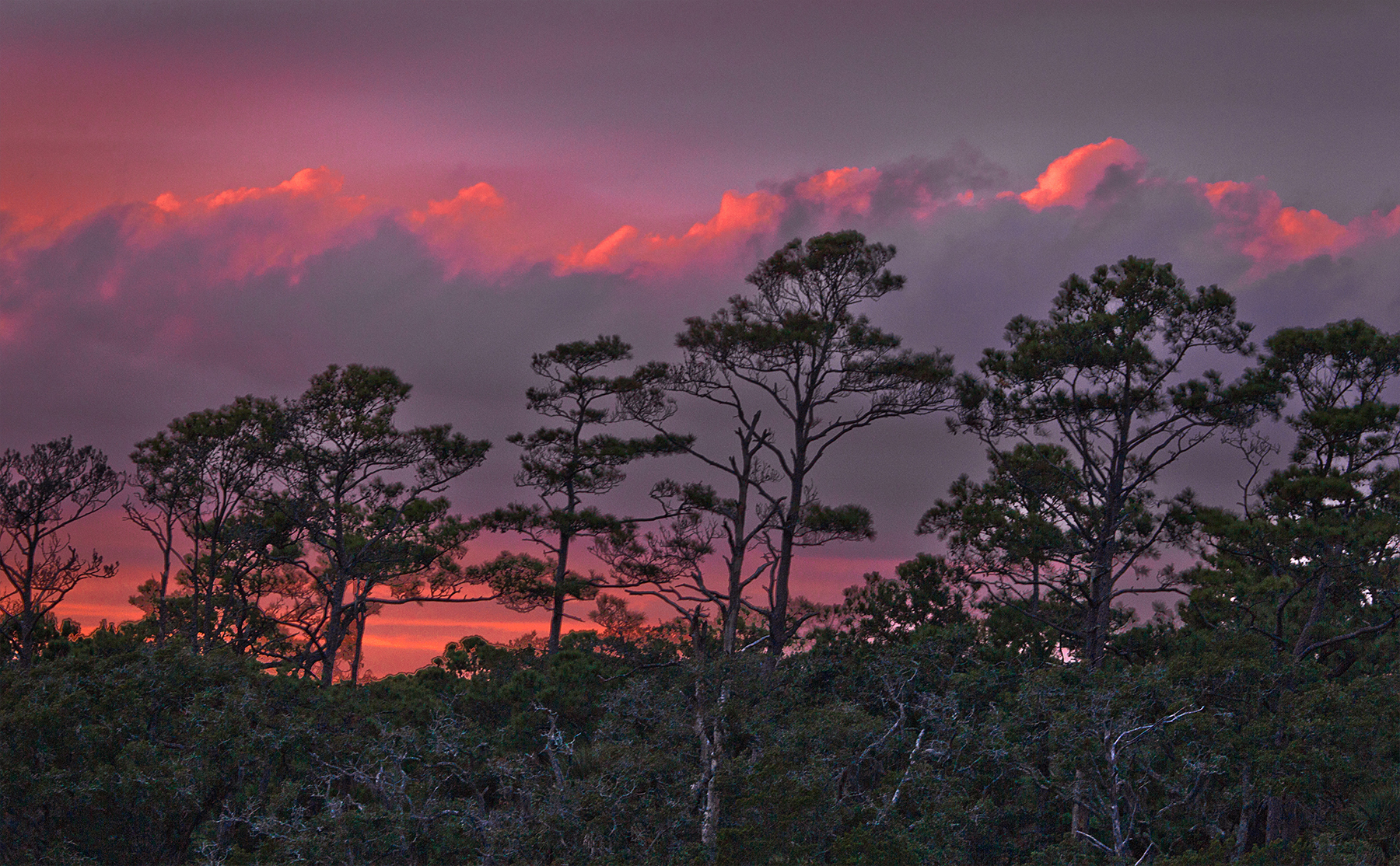Full Text
Fifteen miles south of Charleston, South Carolina, lie the almost impenetrable thickets of a maritime forest. On a 32-square kilometer barrier island named Kiawah, shrubby wax myrtle, characteristic of South Carolina’s maritime forests, is everywhere.
The maritime forest is the spine of Kiawah Island, according to Shauneen Hutchinson of the Kiawah Conservancy, “strong and stately, securing the land when wind and water pummel the place.” The crash of waves breaking mere yards away lets us know how right she is.
|
|
Lovely, Dark, and Deep
Poet Robert Frost wrote of woods that are “lovely, dark and deep.” He might have been referring to a maritime forest.
As coastal ecologists define it, a maritime forest is a tangle of plants that grows cheek by jowl with the sea. Maritime forests are most extensive on the barrier islands of South Carolina and Georgia, according to the report Ecology of Maritime Forests of the Southern Atlantic Coast: A Community Profile by Vincent Bellis. Maritime forests are just that, maritime: connected with or bordering the ocean.
Maritime forests are shaped by salt spray from the sea, the climate of the immediate coast, and extreme disturbance events such as hurricanes and other severe storms. The leaves of many maritime forest plants have waxy coatings to protect them from the salt spray. In South Carolina, maritime forests are dominated by live oak, cabbage palmetto, red bay, yaupon, American holly, wax myrtle, and saw palmetto, among other coastal trees and shrubs.
The best examples of maritime forests may be on small barrier islands and undisturbed coastal hummocks, also called hammock islands (or just hammocks), in lagoons and tidal marshes fringing the mainland.
In some maritime forests, oyster shell-high calcium communities, such as the “Spanish Mount” shell mound at Edisto Beach State Park in South Carolina, line the coast. Oyster shell accumulations hearken back to the early harvesting activities of Native Americans or may be wind-thrown shells. Most maritime forest soils are acidic, but this habitat has basic soils, a result of the shells’ high calcium levels. Unique plant species make a living here: shell mound buckthorn, willow sedge, and, when shell deposits are on open uplands, midden prickly pear.
Requiem for the Maritime Forest?
All is not well in the maritime forest, however.
More frequent storms are exposing these seaside woodlands to increasing salt spray. The change may be partially responsible for the decrease in maritime forest regeneration that’s been observed on barrier islands as far north as Virginia. Salt spray and storm overwash affect the composition of maritime forests. Many plant species are intolerant of high salinity levels, with resulting delays in seed germination.
Where maritime forests survive, their shrub thickets are often cleared for construction, especially for building seaside condo complexes. The entire plant community may be trimmed or removed to make way for clear beach and ocean views. But the move is short-sighted, marine scientists say.
They encourage cluster development—small, closely spaced residential lots and large communal areas of green space, including undisturbed native habitat. New development is clustered on one portion of a property, leaving a large tract of environmentally sensitive or scenic coastal land intact on the remainder of the parcel.
The disappearance of a maritime forest destroys a natural “seawall” that protects barrier islands from storms and high tides. As sea level rises, sand that’s not anchored by tree or shrub roots is likely to be washed away in high waters. “Losing the maritime forest would take away an important buffer for the mainland during hurricanes and other severe storms,” warns Donna Windham, executive director of the Kiawah Conservancy.
|
|
Hurricane Hugo in September 1989 devastated much of the US Southeast, including the coastal Cape Romain National Wildlife Refuge near Awendaw, South Carolina. On Bulls Island within the refuge borders, maritime forest once covered more than 7.8 square kilometers of the barrier island’s total 21.8 square kilometers. Before Hugo, much of that forest was considered old growth, according to William Conner of the Baruch Institute of Coastal Ecology and Forest Science at Clemson University.
A hurricane may, or may not, be a rare occurrence in a maritime forest. Far more often, however, rising sea levels are swamping maritime forests. In the Mid-Atlantic region, sea level is accelerating at three to four times the global average, leading to rapid habitat shifts in coastal areas, including in maritime forests.
As salt water intrudes, tidal wetland species are becoming established in the coastal forest understory. One such species is salt marsh hay, Spartina patens, which had been studied in marshes and dunes but not maritime forests.
Then researchers Emily Kottler and Keryn Gedan of George Washington University identified populations of Spartina patens in these forested uplands. They established plots in marsh and forest understory areas at field sites on the Delmarva peninsula, encompassing parts of the states of Delaware, Maryland, and Virginia, where S. patens is a dominant species.
The coastal ecologists wanted to find out how environmental conditions for S. patens differ between salt marsh and maritime forest habitats.
They found lower salinity and light availability in the maritime forest as compared to the high marsh. The upland understory conditions corresponded with fewer S. patens stems, but greater height and leaf area of S. patens plants.
“There was no flowering observed in [maritime] forest plots, which could have implications for population demographics of this species as it migrates into the forest,” the scientists reported at the 2019 annual meeting of the Ecological Society of America. “Though some traits reflected their habitat of origin, many exhibited strong phenotypic plasticity when transplanted between habitats. This plasticity may prove crucial to the species’ resilience to future change.”
Our footprint falls heavy on the land, especially in maritime forests that are but one small step from an ever-closer sea.



